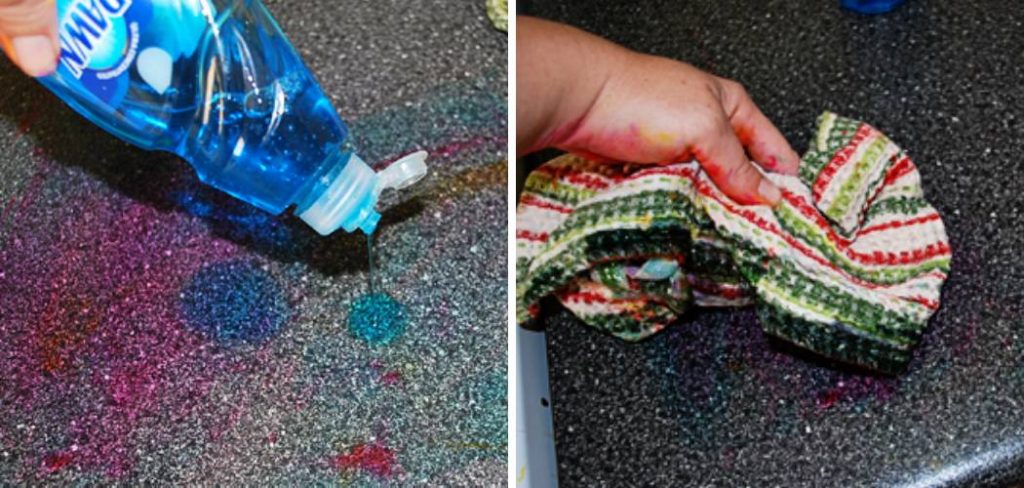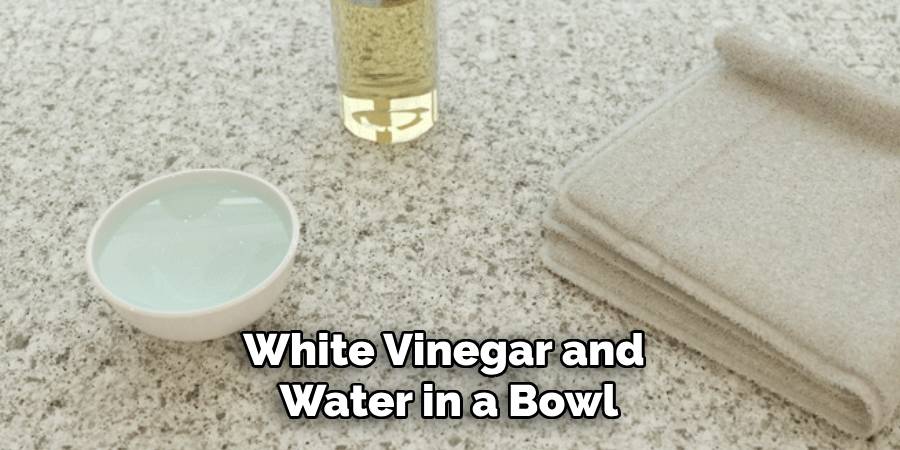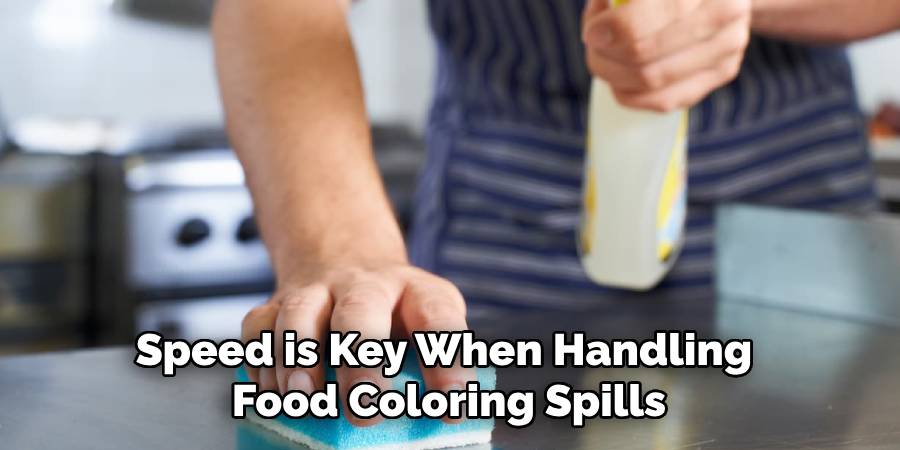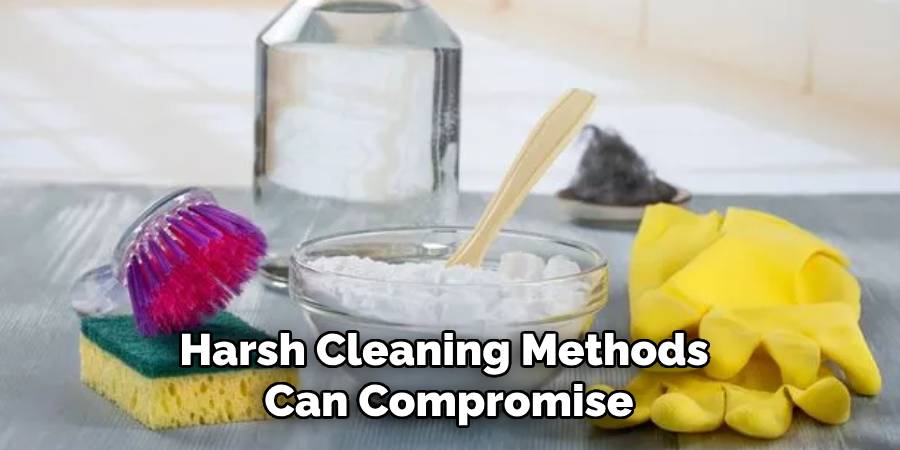Food coloring stains are caused by highly pigmented dyes that can easily seep into porous surfaces, leaving unsightly marks on countertops. These stains can be particularly stubborn, especially if not addressed right away, as they have the potential to cause permanent discoloration on various countertop materials such as granite, marble, laminate, or wood. Understanding how to get food coloring off countertop surfaces quickly and effectively is essential to maintaining the appearance and longevity of your kitchen.

This article aims to provide a comprehensive, step-by-step guide to removing food coloring stains from different countertop materials. Using safe and effective methods, we’ll share practical tips and solutions to help you confidently tackle these stains. From household remedies, such as baking soda and vinegar, to professional cleaning options, this guide will equip you with the knowledge to handle any food coloring mishap.
Understanding Countertop Materials and Stain Risks
Common Countertop Materials
Countertops come in a variety of materials, each with unique qualities that influence how they react to stains:
- Laminate: Laminate countertops are crafted from layers of synthetic materials and are prone to staining, but their non-porous surface makes them relatively easy to clean using mild cleaning solutions.
- Granite & Marble: These natural stone surfaces are porous and require gentle cleaning to avoid scratches or etching. Sealing them regularly helps prevent stains from penetrating deeply.
- Quartz: Quartz countertops are engineered and non-porous, offering excellent resistance to stains. However, even these surfaces benefit from prompt cleaning to avoid discoloration caused by certain dyes.
- Wood & Butcher Block: Highly porous, wood absorbs food coloring dyes quickly. Special care, such as sanding and re-oiling, may be necessary to remove stains effectively.
How Food Coloring Stains Different Surfaces
Food coloring, especially liquid dyes, can quickly penetrate porous countertop materials. Porous surfaces such as wood, granite, and marble are particularly vulnerable because liquid dyes seep into microscopic openings. Darker colors like red or blue pigments are especially challenging to remove since they bind more stubbornly to the surface. Acting quickly is key to minimizing damage and preserving the original appearance of your countertop.
How to Get Food Coloring Off Countertop: Immediate Cleaning Steps for Fresh Stains
Dealing with food coloring stains promptly can significantly reduce their impact on your countertops. Follow these steps to address fresh stains effectively:
Step 1: Blot, Don’t Rub
When you notice a spill, immediately grab a paper towel or a clean, lint-free cloth and gently blot the area. Avoid rubbing, as this could push the dye deeper into the surface, making it harder to remove.

Step 2: Rinse with Warm Water
Prepare a solution of warm water and mild dish soap. Dip a soft sponge or cloth into the solution and gently clean the stained area. The warm water helps loosen the dye molecules, while the soap works to lift them off the surface. Afterward, rinse with plain water and dry the area with a clean towel.
Step 3: Check for Remaining Stains
Inspect the surface to ensure the stain has been removed. If traces of food coloring remain, move on to stronger cleaning techniques suitable for your countertop material. This may involve using a baking soda paste, a commercial cleaning product, or consulting a professional for guidance on deeper cleaning methods. Acting quickly is essential to avoid permanent discoloration.
Removing Food Coloring Stains with Common Household Items
Baking Soda & Water Paste (For Most Surfaces)
Baking soda is a versatile and gentle abrasive that works well on most surfaces. To create a cleaning paste, combine baking soda with a small amount of water until it reaches a thick, spreadable consistency. Apply the paste to the stained area and allow it to sit for about 10 minutes. Once the time has elapsed, use a soft cloth or sponge to scrub the area gently in a circular motion. Rinse thoroughly with clean water and pat the surface dry with a towel.
White Vinegar & Dish Soap Solution (For Laminate & Quartz)
A solution of white vinegar, water, and dish soap is often effective for surfaces like laminate or quartz. Mix equal parts white vinegar and water in a bowl, and add a drop of mild dish soap. Dip a microfiber cloth into the solution and gently wipe the stained area. The acidity of vinegar helps break down the stain, while the dish soap lifts the dye. Once clean, wipe the surface with plain water to remove any residue, then dry with a clean cloth.

Hydrogen Peroxide & Baking Soda (For Light-Colored Stone Surfaces)
You can use a mixture of hydrogen peroxide and baking soda for light-colored stone surfaces, such as marble or granite. Combine the two to form a paste and apply it generously to the stain. Allow it to sit for 15 minutes, giving the peroxide time to lift the dye while the baking soda provides gentle abrasion. Then, rinse the area with water and wipe it dry with a non-abrasive cloth to prevent residue or streaking.
Special Cleaning Methods for Stubborn Stains
Magic Eraser (For Non-Porous Surfaces)
For non-porous surfaces, a damp magic eraser can be a quick and easy solution for stubborn stains. Lightly rub the stain in small, circular motions to gradually lift it. Be cautious not to scrub too hard, as excessive force could dull the surface finish. After removing the stain, wipe the area with a clean, damp cloth to remove any residue.
Rubbing Alcohol (For Tough Stains on Quartz & Laminate)
Rubbing alcohol is an effective remedy for tough stains on quartz and laminate surfaces. Apply a small amount of rubbing alcohol to a cotton ball or soft cloth and blot the stain. The alcohol breaks down the stain and evaporates quickly, leaving no streaks behind. Rinse the area with plain water and dry it thoroughly with a clean cloth to restore its shine.
Lemon Juice & Salt Scrub (For Butcher Block & Wood)
A natural solution like lemon juice and salt can work wonders for butcher block countertops or wooden surfaces. Sprinkle a generous amount of coarse salt over the stain, then use half a lemon to rub the area. The natural acidity of the lemon helps lift the stain, while the salt provides a gentle scrubbing action. Afterward, clean the surface with a damp cloth and apply a small amount of mineral oil to protect the wood and maintain its finish.
Preventing Future Food Coloring Stains
Taking proactive steps to prevent food coloring stains can save time and effort in maintaining your countertops.
Use Cutting Boards & Protective Mats
Always work over a cutting board or protective mat when using food coloring. This provides a barrier between the coloring and your countertops, significantly reducing the likelihood of stains. Silicone mats are particularly effective as they are non-porous and easy to clean.
Clean Up Spills Immediately
Speed is key when handling food coloring spills. The longer the color sits on the surface, the deeper it can penetrate and the more challenging it becomes to remove. Keep a damp cloth handy to blot any spill right away, preventing it from setting into your countertops.

Seal Stone Countertops Regularly
Regular sealing is essential for surfaces like granite and marble to resist stains. A good sealant creates a protective layer on the stone, repelling liquids and particles. Experts recommend resealing stone countertops every 6 to 12 months to maintain their stain resistance and overall durability.
By incorporating these habits into your routine, you can preserve the beauty and longevity of your countertops while minimizing the risk of food coloring stains.
When to Call a Professional
There are instances when professional help is necessary to address stubborn or severe countertop issues.
Permanent Stains on Natural Stone
Natural stone countertops like granite, marble, or quartzite can develop permanent stains if food coloring seeps into the surface despite preventive measures. When DIY methods, such as applying baking soda poultices or specialized cleaners, fail to remove these stains, it’s time to seek professional stone cleaning services. Experts can access advanced cleaning solutions and techniques specially designed for natural stone, restoring your countertop without causing further damage.
Severe Damage to Countertop Finish

The finish acts as a protective layer against stains and damage for wooden or laminate countertops. Prolonged exposure to food coloring or harsh cleaning methods can compromise this finish, leaving the surface vulnerable to further harm. Professional refinishing may be required if you notice persistent discoloration, peeling, or dullness. Refinishing specialists can repair and reapply the protective coating, ensuring your countertop looks as good as new and is protected from future incidents.
Calling a professional addresses the problem effectively and helps maintain the long-term integrity of your countertops, saving you time, effort, and potentially costly replacements.
Conclusion
Knowing how to get food coloring off countertop surfaces effectively is crucial when dealing with food coloring stains. Recap the best methods, including using a baking soda paste, vinegar solutions, rubbing alcohol, and specialized stain removers. Acting quickly is essential to prevent stains from setting and causing permanent damage. Finally, always protect your countertops by using barriers such as cutting boards or parchment paper when working with food coloring. These simple yet effective strategies will help maintain the appearance and longevity of your countertops while avoiding costly repairs or replacements.
Professional Focus
Angela Ervin, a former interior designer turned blogger, specializes in kitchen design and renovations. Through her website, she blends her passion for cooking with design expertise, sharing practical and creative ideas. Known for balancing functionality and beauty, Angela’s insightful content has made her a trusted voice in home design and lifestyle.
About the Author
Angela Ervin, an experienced interior designer and blogger, combines her passion for kitchen renovations with storytelling. Living in Petersburg with her family, she enjoys cooking and testing her projects firsthand. Known for her humor and relatable style, Angela shares creative, functional design insights through her content, making her a trusted voice in home design.
Education History
University: Virginia Commonwealth University
Degree: Bachelor of Fine Arts (BFA) in Interior Design
- Angela’s education at VCU focused on mastering core interior design principles, including spatial planning, color theory, materials selection, and sustainable design practices.
- She gained hands-on experience through studio projects and collaborative design exercises, which honed her ability to create functional and aesthetically pleasing environments.
- Her coursework also emphasized problem-solving and practical applications of design, preparing her for real-world projects like her self-directed kitchen renovations.
- The program’s strong foundation in both technical skills and creative expression shaped Angela’s ability to seamlessly integrate form and function in her work.
